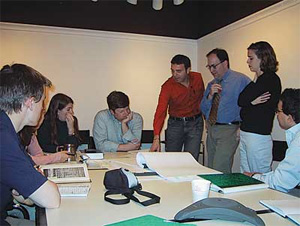
But things began to change as the geographic scope and stature of the design architects grew. Today numerous full-service firms ally themselves with a floating crème de la crème of the design world, the so-alled “starchitects” from out of town or overseas, who need to work with architectural offices familiar with local building codes, zoning regulations, and construction practices, besides knowing how to manage the design process and execute well-detailed working drawings. And now boutique operations show a deeper interest and savvy about building techniques and materials, and want to be involved in the construction-document and construction-administration phases. As for the associated full-service firm, it often likes to get in on the schematic design phases. Still, in 2005, when Frank Gehry, FAIA, joined up with Hugh Hardy, FAIA, and his new firm H3Hardy Collaborative, to design the Theater for a New Audience in downtown Brooklyn, the pairing raised eyebrows in the architecture community. Since Hardy has a strong reputation for theater design, not to mention imaginative renovations, and the job was small (299 seats), some wondered why the union was needed.
Hardy explains that Gehry had been recommended by Rem Koolhaas in 2002 when he and his Office of Metropolitan Architecture (OMA) executed a master plan for the Brooklyn Academy of Music Cultural District with Diller Scofidio + Renfro, of which the theater is a part. Although the Theater for a New Audience came to Hardy, he called Gehry and proposed an alliance. “It’s good to be challenged by others—it stimulates ideas,” says Hardy. Even though Gehry’s name comes first in the billing, Hardy claims he doesn’t mind: “The alphabetical arrangement helps, of course, but I also know it’s sexy for fund-raising.”
The various alliances strike many as enlightening and good for business. They also create tensions, misunderstandings, and sometimes out-and-out fights. Yet the new alignments form a trend significantly coloring architectural practice today. Collaborations between the high-design architect and the local architect or a specialist in a building type owe everything and more to increasing economic globalization, and to the glitter effect of a name architect in a celebrity-immersed culture.


Post a comment to this article
Report Abusive Comment